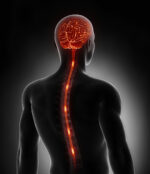Spinal bone fractures a risk, and common, for sarcoidosis patients
Chest X-rays, lung function tests may help define risk of fractures: Study

Bone fractures, particularly those of the spine, are a common complication among people with sarcoidosis, according to a study that assessed nearly 400 patients.
Data showed that sarcoidosis-related lung involvement and reduced lung function were risk factors for major bone fractures.
Chest X-rays examining lung involvement, as well as lung function tests, may help define the risk of bone fractures in sarcoidosis patients, the researchers noted.
Details of the team’s analysis were reported in “Osteoporosis and major fragility fractures (MOF) in sarcoidosis patients: association with disease severity,” a study published in the journal Aging Clinical and Experimental Research,
Osteoporosis common in sarcoidosis due to corticosteroid use
In sarcoidosis, clumps of abnormally activated immune cells called granulomas form in different tissues and organs, including the lungs, liver, heart, gut, muscles, and brain. Over time, these granulomas can become hardened and cause permanent tissue damage.
Sarcoidosis also can affect the bones due to the chronic inflammation associated with the disease. Moreover, corticosteroids — medications used to control abnormal immune reactions — cause bones to become more fragile and prone to fractures or breaks, a condition called osteoporosis.
Despite this, “reports on bone mineral loss or major osteoporosis fracture (MOF) in sarcoidosis are scarce and have conflicting outcomes,” according to researchers at the University of Siena, in Italy.
To address these unknowns, university scientists assessed the history of bone fractures and bone mineral density, a measure of bone strength, in 382 patients with sarcoidosis. The team also examined factors that may contribute to bone fractures in sarcoidosis.
“To the best of our knowledge, this is the first study that evaluated the prevalence and the clinical impact of MOF in a large cohort [group] of sarcoidosis patients,” the researchers noted.
A total of 229 women and 153 men were involved in the single-center study. Their mean age was 55.8.
Unsurprisingly, given that age is a well-known risk factor for osteoporosis, patients with major fractures were older than those without (mean 60.7 vs. 54.3 years).
Spinal fractures by far the most commonly found in study
A total of 90 patients (23.6%) had experienced a major osteoporosis fracture, with 52 reporting a history of more than one fracture. Most fractures — 81 in all — occurred in the bones of the spine, also called the vertebrae. A much smaller number of fractures occurred in limb bones: seven in the wrist, five in the upper arm bone, or humerus, and four in the upper leg bone, or femur.
“An important finding of this study is that approximately a quarter of sarcoidosis patients had a [major fracture] and over a fifth of them had at least one vertebral fracture,” the researchers wrote.
As assessed with a non-invasive approach called dual-energy X-ray absorptiometry, bone density was significantly lower among patients with fractures than those without, particularly in the femoral neck, found at the top of the femur, and the total hip. While the bone density of the lower (lumbar) spine also was lower, the difference was not statistically significant.
The researchers statistically adjusted for age and body mass index (BMI), a measure of body weight relative to height. With that, reduced bone density of the femoral neck, total hip, and lumbar spine significantly correlated with a lower diffusion capacity for carbon monoxide, known as DLCO. DLCO assesses the lungs’ ability to transfer oxygen from the air into the bloodstream.
An important finding of this study is that approximately a quarter of sarcoidosis patients had a [major fracture] and over a fifth of them had at least one vertebral fracture.
Building on these findings, the team examined the patients’ chest X-rays. The prevalence of major fractures was higher among patients with sarcoidosis-related lung involvement than those without (28.3 vs 19.2%), the team found.
The researchers then conducted a statistical analysis that adjusted for factors that may influence the results, including sex, BMI, vitamin D in the blood, lung function and involvement, sarcoidosis therapy, and corticosteroid dose.
These calculations showed that lower DLCO values were linked to a higher risk of osteoporosis, as was a higher BMI. Also, increased lung involvement, a lower total hip bone density, and less sarcoidosis therapy were associated with more major osteoporotic fractures.
“Our data obtained from a large cohort of sarcoidosis patients confirm that MOF and particularly vertebral fracture represent a common and important complication in patients with moderate/severe sarcoidosis,” the authors concluded.








